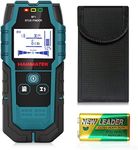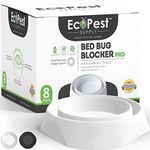Buying Guide for the Best Bug Detectors
When choosing a bug detector, it's important to understand the features and specifications that will best suit your needs. Bug detectors are devices used to detect hidden surveillance devices such as cameras, microphones, and GPS trackers. The right bug detector for you will depend on the type of threats you are concerned about, the environment in which you will be using the detector, and your level of expertise in using such devices. By understanding the key specifications, you can make an informed decision and select a bug detector that effectively meets your requirements.Detection RangeDetection range refers to the distance within which the bug detector can identify hidden devices. This is important because it determines how effectively you can scan an area for bugs. Detection ranges can vary from a few meters to several hundred meters. If you need to scan large areas, such as conference rooms or entire buildings, a detector with a longer range is preferable. For smaller spaces, like a single office or vehicle, a shorter range may suffice. Consider the size of the area you need to cover when choosing the detection range.
Frequency RangeFrequency range indicates the spectrum of frequencies that the bug detector can scan for signals. This is crucial because different surveillance devices operate on different frequencies. A wider frequency range allows the detector to identify a broader array of devices, including those that use unconventional frequencies. If you suspect advanced or varied types of surveillance equipment, opt for a detector with a wide frequency range. For more common threats, a standard frequency range may be adequate.
SensitivitySensitivity refers to the detector's ability to pick up weak signals from hidden devices. High sensitivity is important for detecting low-power devices that might be concealed in walls or furniture. However, too much sensitivity can lead to false positives from non-threatening electronic devices. If you are in an environment with many electronic devices, you may want a detector with adjustable sensitivity to fine-tune the detection process. Choose a sensitivity level based on the complexity of the environment and the likelihood of encountering low-power bugs.
PortabilityPortability is about the size and weight of the bug detector, which affects how easily it can be carried and used in different locations. This is important if you need to conduct sweeps in various places or travel frequently. Smaller, lightweight detectors are easier to carry and use discreetly, while larger models may offer more features but are less convenient to transport. Consider how and where you will be using the detector to determine the right level of portability for your needs.
Ease of UseEase of use refers to how user-friendly the bug detector is, including its interface and the complexity of its operation. This is important because a device that is difficult to use may not be effective in identifying threats. Some detectors come with simple interfaces and clear instructions, making them suitable for beginners. Others may have advanced features that require more technical knowledge. Choose a detector that matches your level of expertise and comfort with technology to ensure effective use.
Battery LifeBattery life indicates how long the bug detector can operate on a single charge or set of batteries. This is important for ensuring that the device can be used for extended periods without needing frequent recharging or battery replacement. Longer battery life is beneficial for thorough sweeps, especially in large areas or when traveling. Consider how long you typically need to use the detector and choose a model with a battery life that meets those needs.















